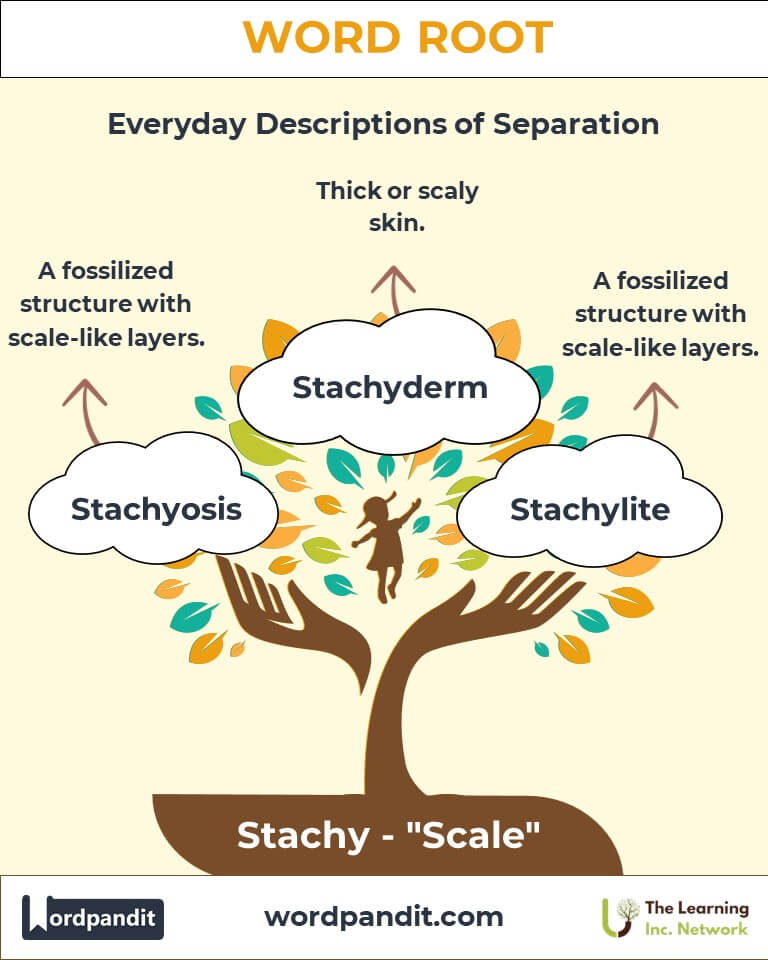Stachy: The Scale of Precision in Language and Medicine
Byline: Delve into the fascinating word root "stachy," derived from Greek, meaning "scale." From intricate medical terms like "squamous" to the process of "desquamation," this root forms the basis for describing layered or scaly structures. Uncover its linguistic journey, practical relevance, and cultural significance.

Table of Contents:
- Introduction: The Essence of "Stachy"
- Etymology and Historical Journey
- Mnemonic: Unlocking the Power of "Stachy"
- Common "Stachy"-Related Terms
- "Stachy" Through Time
- "Stachy" in Specialized Fields
- Illustrative Story: "Stachy" in Action
- Cultural Significance of the "Stachy" Root
- The "Stachy" Family Tree
- FAQs about the "Stachy" Root
- Test Your Knowledge: "Stachy" Mastery Quiz
- Conclusion: The Layered Legacy of "Stachy"
Introduction: The Essence of "Stachy"
Imagine the delicate layering of fish scales or the complex patterns of skin cells under a microscope. The root "stachy", pronounced STAH-kee, captures this essence of scaling and layering. With origins in Greek, "stachy" connects to fields ranging from biology to dermatology, where it describes structures resembling scales or stratified layers. Whether examining squamous cells or understanding skin renewal, "stachy" proves foundational in the language of science and medicine.

Etymology and Historical Journey
The root "stachy" comes from the Greek word stakhys, meaning "ear of grain" or "spike," symbolizing layered or tiered arrangements. Over time, it evolved to represent scaly or stratified structures in anatomical and biological contexts. During the Renaissance, when Latin and Greek terms enriched medical and scientific vocabularies, "stachy" was adopted to describe cells and tissues with scale-like patterns, laying the groundwork for terms still used today.
Mnemonic: Unlocking the Power of "Stachy"
To recall "stachy," picture a stalk of wheat, its grains arranged in precise layers, much like the scales on fish or the stratified cells of skin.
Mnemonic Device: "Stachy stacks up scales in skin and science!"
Common "Stachy"-Related Terms
- Squamous (SKWAY-mus):
- Definition: Flat, scale-like cells found in the epidermis or linings of organs.
- Example: "Squamous epithelial cells protect the body by forming a tough outer layer."
- Desquamation (des-kwuh-MAY-shun):
- Definition: The shedding of the outermost layer of skin cells.
- Example: "Regular desquamation keeps the skin healthy by removing dead cells."
- Stachybotrys (stak-ee-BOT-ris):
- Definition: A genus of mold characterized by layered spores.
- Example: "Stachybotrys, commonly known as black mold, thrives in damp environments."
- Squamule (SKWAY-myool):
- Definition: A small, scale-like structure.
- Example: "The botanist studied squamules on the fern's leaves."
- Squamose (SKWAY-mose):
- Definition: Resembling scales; scaly.
- Example: "The squamose bark of the tree provided a unique texture to its trunk."
"Stachy" Through Time
- Squamous:
- Then: Historically used to describe fish scales or reptilian skin.
- Now: Commonly refers to the flat, scale-like epithelial cells in medical contexts.
- Desquamation:
- Then: A term used in early dermatological studies to describe peeling skin after injuries.
- Now: Integral in understanding skin regeneration and exfoliation processes.
"Stachy" in Specialized Fields
- Dermatology:
- Squamous Cells: Found in the outer layers of skin, essential for protective functions.
- Application: Diagnosis of squamous cell carcinoma, a common skin cancer.
- Microbiology:
- Stachybotrys Mold: Studied for its toxic spores and implications in air quality.
- Application: Essential in managing mold infestations in homes.
- Botany:
- Squamules: Identified in plants for classification purposes.
- Application: Helps distinguish species based on microscopic traits.
Illustrative Story: "Stachy" in Action
Dr. Lila, a dermatologist, was puzzled by a patient with persistent peeling skin. After examining the desquamation process under a microscope, she noticed an abnormal pattern in the squamous cells. Consulting a microbiologist, she discovered that the patient’s condition was linked to Stachybotrys exposure in their home. Her diagnosis led to effective treatment and a safer living environment, showcasing the interconnectedness of "stachy"-rooted sciences.
Cultural Significance of the "Stachy" Root
In ancient cultures, scales often symbolized balance and protection, evident in myths like dragons' scaly armor. Scientifically, "stachy" reflects this layered protection, seen in skin cells and natural defenses. Its cultural resonance extends to modern ecology and conservation, emphasizing harmony and renewal in layered ecosystems.

The "Stachy" Family Tree
- Squam- (Latin: "scale"):
- Squamous: Scale-like.
- Squamule: Tiny scale.
- Strat- (Latin: "layer"):
- Stratum: A layer or level.
- Stratify: To arrange in layers.
- Lamell- (Latin: "thin plate"):
- Lamella: A thin layer or plate.
- Lamellate: Arranged in layers.

FAQs About the "Stachy" Root
Q: What does "Stachy" mean?
A: The root "Stachy" is derived from the Greek word "stakhys," meaning "ear of grain" or "scale." It symbolizes layered or tiered arrangements found in biological and anatomical contexts.
Q: What are squamous cells, and where are they found?
A: Squamous cells are flat, scale-like epithelial cells found in the outer layer of the skin and lining certain internal organs like the lungs and esophagus. They protect underlying tissues from infection, dehydration, and damage.
Q: What is desquamation, and why is it important?
A: Desquamation is the natural shedding of the outermost layer of dead skin cells. This process ensures skin renewal, preventing buildup and contributing to a healthy epidermis.
Q: How does the "stachy" root relate to mold, specifically Stachybotrys?
A: Stachybotrys is a genus of mold known for its layered spores, reflecting the root "stachy." It thrives in damp environments and is associated with health risks due to its toxic spores.
Q: Are "stachy" and "squam" related roots?
A: Yes, both roots describe scale-like structures. "Stachy" generally refers to layered or tiered arrangements, while "squam" focuses on flat or scaly features in anatomy and botany.
Q: What is the function of squamous cells?
A: Squamous cells act as a barrier, protecting underlying tissues from infection, dehydration, and physical damage. They are essential for maintaining the integrity of skin and certain organ linings.
Test Your Knowledge: Stachy Mastery Quiz
1. What does "stachy" signify?
2. Which term describes flat, scale-like cells?
3. What process involves shedding dead skin cells?
4. What does "Stachybotrys" refer to?
5. What role do squamous cells play?
Conclusion: The Layered Legacy of "Stachy"
From biology to linguistics, "stachy" represents the beauty of scaling and layering in natural and scientific phenomena. Its applications in medicine, ecology, and daily life illustrate its versatility and enduring relevance. As we continue to explore the microscopic and macroscopic scales of our world, "stachy" remains a root that layers knowledge and discovery.












